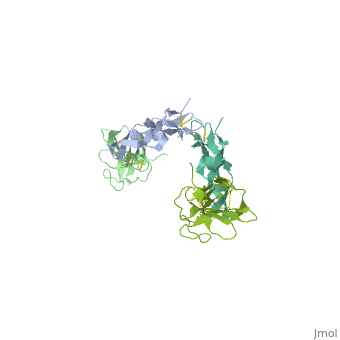TGF-beta receptor: Difference between revisions
Michal Harel (talk | contribs) No edit summary |
Michal Harel (talk | contribs) No edit summary |
||
| Line 13: | Line 13: | ||
== Structural highlights == | == Structural highlights == | ||
TGFBR structure contains a 100-140 residues ligand-binding N-terminal extracellular domain; a transmembrane domain; a 350-400 amino acid cytoplasmic kinase domain; and a C-terminal zona pellucida (ZP) domain of ca 260 residues which has a role in protein polymerization. | TGFBR structure contains a 100-140 residues ligand-binding N-terminal extracellular domain; a transmembrane domain; a 350-400 amino acid cytoplasmic kinase domain; and a C-terminal zona pellucida (ZP) domain of ca 260 residues which has a role in protein polymerization. | ||
== 3D Structures of TGF-β receptor== | |||
[[TGF-β receptor 3D structures]] | |||
</StructureSection> | </StructureSection> | ||
| Line 21: | Line 24: | ||
{{#tree:id=OrganizedByTopic|openlevels=0| | {{#tree:id=OrganizedByTopic|openlevels=0| | ||
* TGF-β receptor I; kinase | * TGF-β receptor I; Domains: extracellular 33-112; kinase 200-503 | ||
**[[1ias]], [[5e8s]] – hTGFBR-I kinase domain – human <br /> | **[[1ias]], [[5e8s]] – hTGFBR-I kinase domain – human <br /> | ||
**[[5e8t]], [[5e8u]] – hTGFBR-I kinase domain (mutant) <br /> | **[[5e8t]], [[5e8u]] – hTGFBR-I kinase domain (mutant) <br /> | ||
**[[5e8w]], [[5e8x]] – hTGFBR-I kinase domain (mutant) + staurosporine<br /> | **[[5e8w]], [[5e8x]] – hTGFBR-I kinase domain (mutant) + staurosporine<br /> | ||
**[[2l5s]] – hTGFBR-I extracellular domain - NMR<br /> | **[[2l5s]] – hTGFBR-I extracellular domain - NMR<br /> | ||
**[[1b6c]] – hTGFBR-I kinase domain + FKBP12 <br /> | **[[1b6c]] – hTGFBR-I kinase domain + FKBP12 <br /> | ||
**[[1py5]], [[3faa]], [[3gxl]], [[3hmm]], [[2wot]], [[2wou]], [[3kcf]], [[2x7o]], [[3tzm]], [[4x0m]], [[4x2j]], [[4x2k]], [[4x2n]] – hTGFBR-I kinase domain + inhibitor <br /> | **[[1py5]], [[3faa]], [[3gxl]], [[3hmm]], [[2wot]], [[2wou]], [[3kcf]], [[2x7o]], [[3tzm]], [[4x0m]], [[4x2j]], [[4x2k]], [[4x2n]], [[5qim]], [[5fri]], [[4x2g]], [[4x2f]] – hTGFBR-I kinase domain + inhibitor <br /> | ||
**[[5e8z]], [[5qik]], [[5qil]], [[5qtz]], [[5qu0]], [[6b8y]], [[5e90]] – hTGFBR-I kinase domain (mutant) + inhibitor<br /> | |||
**[[1vjy]] – hTGFBR-I residues 1-303 + inhibitor <br /> | **[[1vjy]] – hTGFBR-I residues 1-303 + inhibitor <br /> | ||
**[[5usq]] – hTGFBR-I residues 123-421 + inhibitor <br /> | **[[5usq]] – hTGFBR-I residues 123-421 + inhibitor <br /> | ||
**[[1rw8]] – hTGFBR-I truncated kinase domain + inhibitor <br /> | **[[1rw8]] – hTGFBR-I truncated kinase domain + inhibitor <br /> | ||
**[[6mac]] – hTGFBR-I extracellular domain + GDF-11 + activin receptor 2B- <br /> | |||
* TGF-β receptor II | * TGF-β receptor II | ||
| Line 38: | Line 42: | ||
**[[1m9z]] – hTGFBR-II extracellular domain <br /> | **[[1m9z]] – hTGFBR-II extracellular domain <br /> | ||
**[[1plo]], [[4p7u]] – hTGFBR-II extracellular domain (mutant) - NMR<br /> | **[[1plo]], [[4p7u]] – hTGFBR-II extracellular domain (mutant) - NMR<br /> | ||
**[[4xjj]] – hTGFBR-II extracellular domain (mutant) + inhibitor<br /> | |||
**[[5e8v]] – hTGFBR-II kinase domain (mutant) <br /> | **[[5e8v]] – hTGFBR-II kinase domain (mutant) <br /> | ||
**[[5e8y]] – hTGFBR-II kinase domain (mutant) + staurosporine<br /> | **[[5e8y]] – hTGFBR-II kinase domain (mutant) + staurosporine<br /> | ||
**[[5e92]] – hTGFBR-II kinase domain (mutant) + AMPPNP<br /> | **[[5e92]] – hTGFBR-II kinase domain (mutant) + AMPPNP<br /> | ||
**[[ | **[[5qin]], [[5e91]] – hTGFBR-II kinase domain + inhibitor <br /> | ||
**[[1ktz]] – hTGFBR-II extracellular domain + TGF-β3 <br /> | **[[1ktz]] – hTGFBR-II extracellular domain + TGF-β3 <br /> | ||
**[[5ty4]] – hTGFBR-II extracellular domain + mmTGF-β2 <br /> | **[[5ty4]] – hTGFBR-II extracellular domain + mmTGF-β2 <br /> | ||
**[[5tx4]] – mTGFBR-II extracellular domain (mutant) + hTGF-β2 - mouse<br /> | **[[5tx4]] – mTGFBR-II extracellular domain (mutant) + hTGF-β2 - mouse<br /> | ||
**[[1ks6]] – cTGFBR-II extracellular domain - chicken<br /> | |||
* TGF-β receptor III | * TGF-β receptor III | ||
Revision as of 14:20, 16 February 2020
FunctionTGF-β receptors (Transforming Growth Factor) (TGFBR) are serine/threonine kinase receptors. They are involved in paracrine signaling and are found in many types of tissue. TGF-β ligands include bone morphogenetic proteins, growth and initiation factors, anti-Mullerian hormone, activin, nodal TGF-β[1]. There are 3 types of TGFBR:
DiseaseOver-expression of TGF causes kidney disease, diabetes and renal disease. Mutations in TGFBR II cause various types of tumors[2]. Structural highlightsTGFBR structure contains a 100-140 residues ligand-binding N-terminal extracellular domain; a transmembrane domain; a 350-400 amino acid cytoplasmic kinase domain; and a C-terminal zona pellucida (ZP) domain of ca 260 residues which has a role in protein polymerization. 3D Structures of TGF-β receptor
|
| ||||||||||
3D Structures of TGF-β receptor3D Structures of TGF-β receptor
Updated on 16-February-2020
ReferencesReferences
- ↑ Wrana JL. TGF-beta receptors and signalling mechanisms. Miner Electrolyte Metab. 1998;24(2-3):120-30. PMID:9525694
- ↑ Frischmeyer-Guerrerio PA, Guerrerio AL, Oswald G, Chichester K, Myers L, Halushka MK, Oliva-Hemker M, Wood RA, Dietz HC. TGFbeta receptor mutations impose a strong predisposition for human allergic disease. Sci Transl Med. 2013 Jul 24;5(195):195ra94. doi: 10.1126/scitranslmed.3006448. PMID:23884466 doi:http://dx.doi.org/10.1126/scitranslmed.3006448
